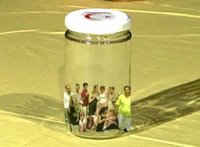In Their Own Words: The Summer of Pathos
 | Alliances were very confused during the fighting in 1974. Greek colonels commanded the Greek Cypriot National Guard; while Turkish officers who landed at Kyrenia swiftly pressed young Turkish Cypriot men into fighting. Cypriots couldn’t always tell who their enemies were. Greek Cypriot fought against Greek Cypriot to repress the coup against Archbishop |
| A Paphiot village priest .............................................. | Makarios, who was then the president of Cyprus. Here are three |
|---|
Papalazaros Neofytou, the man pictured above, was a Greek Orthodox priest in a small village in Paphos in 1974. (He remains so today.) Paphos, an aptly named district that evokes all of the sadness endured there that summer, is still one of the island’s most sparsely-populated districts. But until 1974, it was also one of the most integrated parts of the Cyprus, with Greek and Turkish Cypriot villages close at hand.
The priest said that two of his sons died that summer. He believes that one son was killed by EOKA-B, a Greek Cypriot paramilitary group that tried to overthrow Archbishop Makarios; while the other son died fighting the Turks. Before that summer, he had nine children, four boys and five girls.
This interview took place in front of the Greek Cypriot parliament building on July 15th, 2005, after an official ceremony marking the anniversary of the coup. The priest spoke in Greek, which was more-or-less simultaneously translated into English by both the priest’s son and an independent translator.
Papalazaros Neofytou: When the coup happened, I thought that EOKA-B would try to kill me because I supported Makarios. As the village priest, of course I supported Archbishop Makarios. So I moved from my house, and they didn’t find me. But EOKA-B found my son, who was hiding in the Bishop’s building in Paphos, and killed him. He was only 17 years old.
I had another son, Sotiris, who was studying medecine in Moscow. He was 21 years old. He was in Cyprus for the summer vacation. When Turkey invaded Cyprus, we had to fight the Turkish Cypriots, because they supported the Turkish invasion. Turkey invaded in Kyrenia, so when the Turks got to Limassol, we had to fight them so we would not have trouble from them. During the fighting in Limassol, Sotiris was killed.
In 1974, Tamer Burhan Garip was 12 years old. He lives in north Cyprus now, and I interviewed him after a Turkish Cypriot protest in north Nicosia last July 15th, when he said that he still supported the peace process, and the Turkish Cypriots were “still keeping the yes vote.” But he was clearly growing impatient, and he said if they had to wait too much longer for the Greek Cypriots to resume negotiations, “the mood will no longer be reunification, it will be liberation,” meaning a return to the Turkish Cypriot bid for independence. Here are his memories of 1974.
Tamer Burhan Garip: My parents used to produce wine in Paphos. We had 40 hectares and 60 acres of apples. One of my brothers was taken hostage by EOKA in 1974, and another brother had to go to the front.
My one brother was 15 or 16 when he was taken hostage. He was staying with my grandmother near Agia Nicholas, near Paphos. He sent a letter to my parents through the Red Cross saying that if they didn’t rescue him he was going to kill himself. My father went to a U.N. man and he drove in a U.N. car to the village and found my brother, put him in the trunk and drove him to this side. My other brother was 17. He was called up by the Turkish Army. And my father decided that if my brother went that he would go, too. So he went as a translator for the Turkish Army.
I interviewed Chrystalla Tsoutsouki, a Maronite Cypriot, one hot summer afternoon in Kormakitis, the largest of four traditional Maronite villages, which are all on the Turkish side of the island today. For centuries, Cyprus has had a small community of Maronite Christians, which is an ancient Catholic rite based in Lebanon. Although a few of the older Maronite Cypriots remain in Kormakitis, under very limited circumstances, now most of them either live on the Greek side of Nicosia, or they’ve emigrated abroad. Ms. Tsoutsouki was a young girl growing up in Kormakitis in the summer of 1974.
Chrystalla Tsoutsouki: We were safer because we were a neutral community, so the Turkish planes avoided these four villages. I remember when they occupied the village. They took the women and children into the town’s elementary school, and then they took all the men 16 and older away for two days. When the men came back, there was so much relief.
In the beginning, we could only come over from the Greek side for Christmas and Easter. They used to bring us at night in buses, so we couldn’t see. They would inspect our luggage. It cost twenty Cypriot pounds for the visa, and I say “visa” in quotation marks. The U.N. had always tried to protect enclave people, but in war and military situations, it isn’t always easy to implement international human rights.
Maybe we speak Greek, but we are a third community. The people in Kormakitis had the best relationship with the Turkish Cypriots. We are the kids of those people. I’m over 40, and our parents always taught us that this land belongs to all of us. We have to co-exist with the Turkish Cypriots and the Greek Cyriots. We must stay out of this conflict.
tCr






0 Comments:
Post a Comment
<< Back to tCr Home